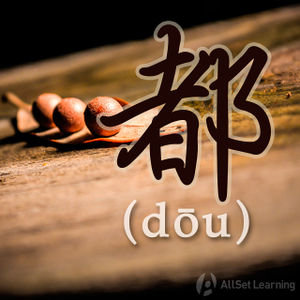Difference between revisions of "Indicating the whole with "quan""
m (Text replace - "{{Grammar Box}} " to "{{Grammar Box}} ") |
m (Text replace - "(\r?\n){2}" to "\r\n") |
||
| Line 1: | Line 1: | ||
| − | {{Grammar Box}} | + | {{Grammar Box}} \r\nOne of the uses of 全 (quán) is to indicate the entirety of something. It could be used for something like a ''whole'' household, an ''entire'' country, the ''whole'' world, etc.\r\n== Structure ==\r\nThe structure is quite simple, just put 全 in front of the noun you want to emphasize "the whole" of. You cannot use it with 的. Pay attention to the types of nouns you can use with 全, since it is usually paired up with 国 (country), 世界 (world), 家 (family), 天 (day), 球 (the globe), and the like. \r\n<div class="jiegou">\r\n全 + Noun\r\n</div>\r\n== Examples ==\r\n<div class="liju">\r\n* 我们 <em>全</em>家 都 去 旅游 了。<span class="trans">The entire family went traveling.</span> |
| − | |||
| − | |||
| − | |||
| − | == Structure == | ||
| − | |||
| − | |||
| − | |||
| − | <div class="jiegou"> | ||
| − | |||
| − | |||
| − | |||
| − | </div> | ||
| − | |||
| − | == Examples == | ||
| − | |||
| − | <div class="liju"> | ||
| − | |||
| − | * 我们 <em>全</em>家 都 去 旅游 了。<span class="trans">The entire family went traveling.</span> | ||
* 明天 我 <em>全</em> 天 都 呆 在 家里。<span class="trans">I am going to stay home all day tomorrow.</span> | * 明天 我 <em>全</em> 天 都 呆 在 家里。<span class="trans">I am going to stay home all day tomorrow.</span> | ||
* 你 知道 <em>全</em> 国 有 几 个 省 吗?<span class="trans">Do you know how many provinces the country has?</span> | * 你 知道 <em>全</em> 国 有 几 个 省 吗?<span class="trans">Do you know how many provinces the country has?</span> | ||
| Line 23: | Line 5: | ||
* <em>全</em>世界 的 人 都 知道 我 是 谁,你 不 知道?<span class="trans">The whole world knows who I am. Don't you know?</span> | * <em>全</em>世界 的 人 都 知道 我 是 谁,你 不 知道?<span class="trans">The whole world knows who I am. Don't you know?</span> | ||
* 这 场 战争 影响 到 <em>全</em>美国。<span class="trans">This war is affecting all of America.</span> | * 这 场 战争 影响 到 <em>全</em>美国。<span class="trans">This war is affecting all of America.</span> | ||
| − | * 请 你 读 一下 <em>全</em> 文。<span class="trans">Please read the full text.</span> | + | * 请 你 读 一下 <em>全</em> 文。<span class="trans">Please read the full text.</span>\r\n</div>\r\n==See also==\r\n*[[Referring to "all" using "suoyou"]] |
| − | |||
| − | </div> | ||
| − | |||
| − | ==See also== | ||
| − | |||
| − | *[[Referring to "all" using "suoyou"]] | ||
*[[Expressing "Everyone" with "shei"]] | *[[Expressing "Everyone" with "shei"]] | ||
*[[Expressing "All" with "shenme dou"]] | *[[Expressing "All" with "shenme dou"]] | ||
*[[Expressing "Every" with "mei" and "dou"]] | *[[Expressing "Every" with "mei" and "dou"]] | ||
| − | *[[Emphasizing quantity with "dou"]] | + | *[[Emphasizing quantity with "dou"]]\r\n== Sources and further reading ==\r\n=== Books ===\r\n* [[现代汉语八百词]] (p.457) [http://www.amazon.cn/mn/detailApp?_encoding=UTF8&tag=allset-23&linkCode=as2&asin=B001198GSW&camp=536&creative=3132&creativeASIN=B001198GSW →buy]\r\n[[Category:B1 grammar points]] |
| − | |||
| − | == Sources and further reading == | ||
| − | |||
| − | === Books === | ||
| − | |||
| − | * [[现代汉语八百词]] (p.457) [http://www.amazon.cn/mn/detailApp?_encoding=UTF8&tag=allset-23&linkCode=as2&asin=B001198GSW&camp=536&creative=3132&creativeASIN=B001198GSW →buy] | ||
| − | |||
| − | [[Category:B1 grammar points]] | ||
{{Basic Grammar|全|B1|全+Noun.|我们 <em>全</em>家 都 去 旅游 了。|grammar point|ASGCPDSR}} | {{Basic Grammar|全|B1|全+Noun.|我们 <em>全</em>家 都 去 旅游 了。|grammar point|ASGCPDSR}} | ||
{{Rel char|都}} | {{Rel char|都}} | ||
Revision as of 06:09, 26 November 2013
-
Level
-
Similar to
-
Used for
-
Keywords
\r\nOne of the uses of 全 (quán) is to indicate the entirety of something. It could be used for something like a whole household, an entire country, the whole world, etc.\r\n== Structure ==\r\nThe structure is quite simple, just put 全 in front of the noun you want to emphasize "the whole" of. You cannot use it with 的. Pay attention to the types of nouns you can use with 全, since it is usually paired up with 国 (country), 世界 (world), 家 (family), 天 (day), 球 (the globe), and the like. \r\n
\r\n== Examples ==\r\n
- 明天 我 全 天 都 呆 在 家里。I am going to stay home all day tomorrow.
- 你 知道 全 国 有 几 个 省 吗?Do you know how many provinces the country has?
- 现在 是 全 球 经济 发展 最 快 的 时候。Now is when the whole world is quickly developing economically.
- 全世界 的 人 都 知道 我 是 谁,你 不 知道?The whole world knows who I am. Don't you know?
- 这 场 战争 影响 到 全美国。This war is affecting all of America.
- 请 你 读 一下 全 文。Please read the full text.\r\n
\r\n==See also==\r\n*Referring to "all" using "suoyou"



